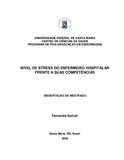| dc.creator | Sarturi, Fernanda | |
| dc.date.accessioned | 2009-11-30 | |
| dc.date.available | 2009-11-30 | |
| dc.date.issued | 2009-08-14 | |
| dc.identifier.citation | SARTURI, Fernanda. STRESS LEVEL OF HOSPITAL NURSES AND YUORS COMPETENCES. 2009. 125 f. Dissertação (Mestrado em Enfermagem) - Universidade Federal de Santa Maria, Santa Maria, 2009. | por |
| dc.identifier.uri | http://repositorio.ufsm.br/handle/1/7317 | |
| dc.description.abstract | This study aimed to verify the level of stress of hospital nurses, to characterize the population, identify the stressing activities, associate the stressing activities to the level of stress and analyze the correlation between the areas of stress in institutions, compare the level of stress with the socio-demographic variables. This is a field research, exploratory and descriptive with quantitative approach carried out with 214 nurses from
two hospitals (A and B) in Santa Maria / RS. For data collection it was used a tool adapted from Bianchi (1990,1999) and Anabuki (2001) - The Daily Stressors Of Hospital Nurses consisting of 55 activities (Likert scale) and 12 socio-demographic questions. The data were stored in a spreadsheet in Excel (version XP) and statistically analyzed using SAS and SPSS softwares. It was performed the standardization of the stress scores, attested the instrument's internal consistency by the Cronbach's alpha
coefficient, applied the chi-square test and Kruskal-Wallis, using a significance level of 5% and held the correlation of Spearman. It was found that the Cronbach alpha coefficient is above 0,70; in the institution A the population is female, average age of 42,29 years, working in the institution an average of 13,35 years, and post graduate an average of 82,27%; In institution B the population is female, average age of 33,87 years,
working in the institution an average of 6,34 years and post-graduate an average of 73,97%, the variable post-graduate meant a significant difference in the level of stress of the nurses of institution A, the highest score of stress was identified for the activities of the area - working conditions for the performance of activities of nurses, the level of stress is down to 45,39% for the nurses of the institution A and 49,32% for the nurses of
the institution B and the competence and skill for general administration and management is associated with all levels of stress. From the results it appears that the
hypotheses of this study were confirmed. | eng |
| dc.format | application/pdf | por |
| dc.language | por | por |
| dc.publisher | Universidade Federal de Santa Maria | por |
| dc.rights | Acesso Aberto | por |
| dc.subject | Stress | por |
| dc.subject | Enfermeiro | por |
| dc.subject | Atividade | por |
| dc.subject | Competência | por |
| dc.subject | Stress | eng |
| dc.subject | Nurses | eng |
| dc.subject | Activity | eng |
| dc.subject | Competence | eng |
| dc.title | Nível de stress do enfermeiro hospitalar frente a suas competências | por |
| dc.title.alternative | Stress level of hospital nurses and yuors competences | eng |
| dc.type | Dissertação | por |
| dc.description.resumo | Este estudo teve como objetivo verificar o nível de stress dos enfermeiros hospitalares; caracterizar a população, identificar as atividades estressoras, associar as atividades
estressoras ao nível de stress; analisar a correlação entre as áreas de stress das instituições e comparar o nível de stress as variáveis sócio-demográficas. Trata-se de uma pesquisa de campo, exploratória, descritiva com abordagem quantitativa realizada com 214 enfermeiros de duas instituições hospitalares (A e B) em Santa Maria/RS. Para coleta dos dados utilizou-se um instrumento adaptado de Bianchi (1990,1999) e Anabuki (2001) - Estressores das Atividades Diárias do Enfermeiro Hospitalar com 55 atividades (escala tipo Likert) e 12 questões sócio-demográficas. Os dados foram
armazenados em uma planilha no Excel (versão XP) e analisados estatisticamente com auxílio dos programas SAS e SPSS. Foi realizada a padronização dos escores de stress; atestada a consistência interna do instrumento pelo Coeficiente Alfa de Cronbach; aplicados os testes qui-quadrado e kruskal-wallis; utilizado um nível de significância de 5% e realizada a Correlação de Spearman. Verificou-se que: o Coeficiente Alfa de Cronbach é superior a 0,70; na Instituição A a população é feminina, com média de idade de 42,29 anos, trabalham na instituição a uma média de 13,35
anos e, possuem pós-graduação 82,27%; na Instituição B a população é feminina, com média de idade de 33,87 anos, trabalham na instituição a uma média de 6,34 anos e,
possuem pós-graduação 73,97%; a variável pós-graduação apresentou diferença significativa em relação ao nível de stress dos enfermeiros da Instituição A; a maior média de escore de stress foi identificada para às atividades da área - Condições de trabalho para o desempenho das atividades do enfermeiro; o nível de stress é baixo para 45,39% dos enfermeiros da Instituição A e 49,32% para os sujeitos da Instituição B e, a competência e habilidade geral para Administração e gerenciamento esta associada a todos os níveis de stress. A partir dos resultados obtidos verifica-se que as hipóteses desta pesquisa foram confirmadas. | por |
| dc.contributor.advisor1 | Lopes, Luis Felipe Dias | |
| dc.contributor.advisor1Lattes | http://buscatextual.cnpq.br/buscatextual/visualizacv.do?id=K4721614Z9 | por |
| dc.contributor.advisor-co1 | Guido, Laura de Azevedo | |
| dc.contributor.advisor-co1Lattes | http://buscatextual.cnpq.br/buscatextual/visualizacv.do?id=K4770022P7 | por |
| dc.contributor.referee1 | Garcia, Vera Regina Real Lima | |
| dc.contributor.referee1Lattes | http://buscatextual.cnpq.br/buscatextual/visualizacv.do?id=K4780639D7 | por |
| dc.creator.Lattes | http://buscatextual.cnpq.br/buscatextual/visualizacv.do?id=K4711262P2 | por |
| dc.publisher.country | BR | por |
| dc.publisher.department | Enfermagem | por |
| dc.publisher.initials | UFSM | por |
| dc.publisher.program | Programa de Pós-Graduação em Enfermagem | por |
| dc.subject.cnpq | CNPQ::CIENCIAS DA SAUDE::ENFERMAGEM | por |


